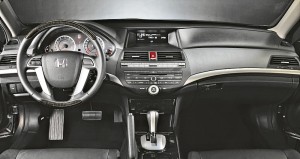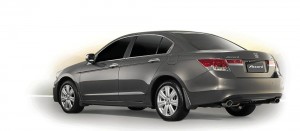Executive sedan with the soul of a sports car
The midsize executive sedan market composed of the Honda Accord, Toyota Camry, Nissan Teana and the Subaru Legacy, which is just outside of the luxury sports sedans of BMW, Mercedes-Benz, Audi and Lexus, has in recent years been shrinking, relative to the growth of the other key segments in the industry.
People seem to be going down-market (smaller, more fuel-efficient cars), going elsewhere to the SUV/pick-up diesel market which is perhaps the mostly hotly contested segment and a good number have been going up-market as well as aggressive discounting, promos and trade-in deals from the luxury marques have attracted a new generation of affluent car-buyers unafraid of displaying their newfound wealth and brand loyalty.
But this isn’t a market analysis. Rather, this is a look into a sedan which outmuscles a lot of the entry-level luxury marques, is packed with more features and options, clothed in a futuristic, Neo-Japanese silhouette, and has the soul of a sports car. We’re talking of the mildly refreshed 2011 Honda Accord V6.
First the engine: the 3.5 liter V6 engine has dual-overhead camshafts and 24 valves with i-vtec and more importantly, variable cylinder/displacement management to help lessen the impact of feeding six hungry cylinders with premium unleaded in situations where all 275 horses and 34.5kg/m of torque are not needed, such as idling in traffic. But the engine truly is the piece-de-resistance of the Accord. The 2.4 is just too plain slow, weighing in at 1535kg while the V6, despite packing an extra 100kg’s at 1635 feels just right, the heft only felt when cornering hard, especially when laden with people inside.
The double-wishbone front and multi-link rear suspension does feel rather bouncy, whereas the previous Accord I drove some two years back felt like the suspension had better rebound control and excellent compliance over the rough stuff, whereas this one felt rather floaty at speeds in excess of 100km/h. And that is a concern indeed as the V6 can easily propel you toward 180km/h and beyond, realistically into the 220km/h range given any decent stretch of road longer than one kilometer. Thankfully, the ABS-EBD with brake-assist brakes has the stopping power to match the firepower packed by the V6. But the overly light steering which lacks feel, perhaps caused by the weight of the big V6 up front, means it’s not the b-road burner we’ve expected Hondas of the past to be. The wheels and tires measure a hefty 17-inches with 225/50 all-season performance tires, but a nice set of 18 or even 19 inch wheels with more wider, more aggressive high-performance tires will definitely look very much at home in the Accord’s prodigious wheel wells, and perhaps offer better performance, feel and connection to the road.
The engine noise reminds me of Honda’s NSX at full-tilt: shrill, distinct, very mechanical, almost a Germanic feel to it rather than the raspy, almost digitized Japanese V6 soundtrack of Nissan’s VQ family of V6 engines and all their variants, or the GR V6’s of Toyota which unfortunately, sound too muted, lacking excitement in this case. The Accord’s V6 feels at home at or near the redline, and in the Accord’s case, spearing down a deserted stretch of highway road as fast as conditions allow. You’d do that not because you want to go fast, but going fast is a by-product of hearing that wonderful V6. Too bad the heavily insulated interior muffles almost everything out, especially if the windows are up, the excellent audio system on and a conversation with passengers happening. Roll down the windows and let the symphony of valves, pistons and connecting rods come on in and you’ll know what I mean. If car sales were based on engine noise alone, the Honda and Nissan would be neck and neck.
As a passenger, you’re greeted by excellent space and refinement, and softer, more supple leather compared to the previous generation Accord and trying to bridge the gap between the premium car of a mass-market to the entry-level luxury marques. It goes without saying that the Accord represents far better value and straight-line performance, not to mention cheaper after-sales servicing and potentially a more solid resale-value compared with the entry-level premium/luxury sports sedans.
iPod and Bluetooth mobile-phone connectivity are standard, as are front and rear sensors to aid parking the admittedly large sedan. There are paddle-shifters as well to help you get into the mood, but the algorithm for the Accord V6’s 5-speed automatic transmission is very good. Other noteworthy aspects of the Accord is the excellent driving position and the myriad range of adjustments a driver can achieve to gain the best, most comfortable and ergonomically correct position. 8-way power seats up front plus tilt/telescopic adjustment means Honda indeed takes the owner-driven market seriously.
The 6-CD audio system with aforementioned iPod connectivity and subwoofer is excellent: I’ve played trash, bootleg music and could hear the most distinct of noises which was refreshing; proof that I’ve not yet completely grown deaf from too much boy-racer/track cars with loud induction, turbo, exhaust and blow-off valves wooshing and more importantly, engine knock, I pray.
The Honda Accord is not the keenest of driving tools, I have to admit. The heavy front end combined with loads of torque, a floaty suspension and overly light interface, that is steering, brakes and throttle means it’s more capable as a long-distance cruiser or an executive assistant that patiently awaits your inputs in stop-and-go traffic while entertaining you with her charms. I found it difficult to find the Accord’s comfortable pace in everyday driving as I’d be either too slow or too fast in the conditions I was in, except for the open highway where the Accord just begs to be floored, with all the stops removed.
But for a busy executive looking for value, comfort and a good bit of naughty straight-line performance, it’s very hard to beat the Accord.



